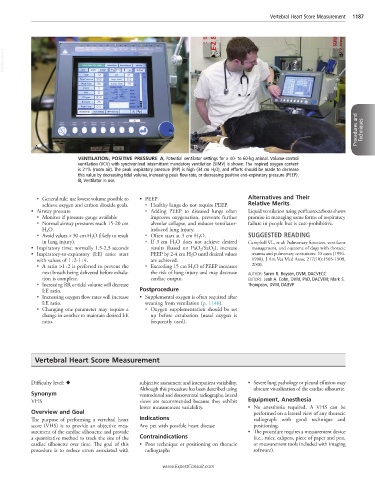Page 2401 - Cote clinical veterinary advisor dogs and cats 4th
P. 2401
Vertebral Heart Score Measurement 1187
VetBooks.ir
Procedures and Techniques
A B
VENTILATION, POSITIVE PRESSURE A, Potential ventilator settings for a 40- to 60-kg animal. Volume-control
ventilation (VCV) with synchronized intermittent mandatory ventilation (SIMV) is shown. The inspired oxygen content
is 21% (room air). The peak inspiratory pressure (PIP) is high (34 cm H 2 O), and efforts should be made to decrease
this value by decreasing tidal volume, increasing peak flow rate, or decreasing positive end-expiratory pressure (PEEP).
B, Ventilator in use.
○ General rule: use lowest volume possible to • PEEP Alternatives and Their
achieve oxygen and carbon dioxide goals. ○ Healthy lungs do not require PEEP. Relative Merits
• Airway pressure ○ Adding PEEP to diseased lungs often Liquid ventilation using perfluorocarbons shows
○ Monitor if pressure gauge available improves oxygenation, prevents further promise in managing some forms of respiratory
○ Normal airway pressures reach 15-20 cm alveolar collapse, and reduces ventilator- failure in people but is cost-prohibitive.
H 2O. induced lung injury.
○ Avoid values > 30 cm H 2 O (likely to result ○ Often start at 3 cm H 2O. SUGGESTED READING
in lung injury). ○ If 3 cm H 2O does not achieve desired Campbell VL, et al: Pulmonary function, ventilator
• Inspiratory time: normally 1.5-2.5 seconds results (based on PaO 2/SaO 2 ), increase management, and outcome of dogs with thoracic
• Inspiratory-to-expiratory (I:E) ratio: start PEEP by 2-4 cm H 2 O until desired values trauma and pulmonary contusions: 10 cases (1994-
with values of 1 : 2-1 : 4. are achieved. 1998). J Am Vet Med Assoc 217(10):1505-1509,
○ A ratio >1 : 2 is preferred to prevent the ○ Exceeding 15 cm H 2 O of PEEP increases 2000.
next breath being delivered before exhala- the risk of lung injury and may decrease AUTHOR: Søren R. Boysen, DVM, DACVECC
tion is complete. cardiac output. EDITORS: Leah A. Cohn, DVM, PhD, DACVIM; Mark S.
○ Increasing RR or tidal volume will decrease Thompson, DVM, DABVP
I:E ratio. Postprocedure
○ Increasing oxygen flow rates will increase • Supplemental oxygen is often required after
I:E ratio. weaning from ventilation (p. 1146).
○ Changing one parameter may require a ○ Oxygen supplementation should be set
change in another to maintain desired I:E up before extubation (nasal oxygen is
ratio. frequently used).
Vertebral Heart Score Measurement
Difficulty level: ♦ subjective assessment and interpatient variability. • Severe lung pathology or pleural effusion may
Although this procedure has been described using obscure visualization of the cardiac silhouette.
Synonym ventrodorsal and dorsoventral radiographs, lateral
VHS views are recommended because they exhibit Equipment, Anesthesia
lower measurement variability. • No anesthesia required. A VHS can be
Overview and Goal performed on a lateral view of any thoracic
The purpose of performing a vertebral heart Indications radiograph with good technique and
score (VHS) is to provide an objective mea- Any pet with possible heart disease positioning.
surement of the cardiac silhouette and provide • The procedure requires a measurement device
a quantitative method to track the size of the Contraindications (i.e., ruler, calipers, piece of paper and pen,
cardiac silhouette over time. The goal of this • Poor technique or positioning on thoracic or measurement tools included with imaging
procedure is to reduce errors associated with radiographs software).
www.ExpertConsult.com

